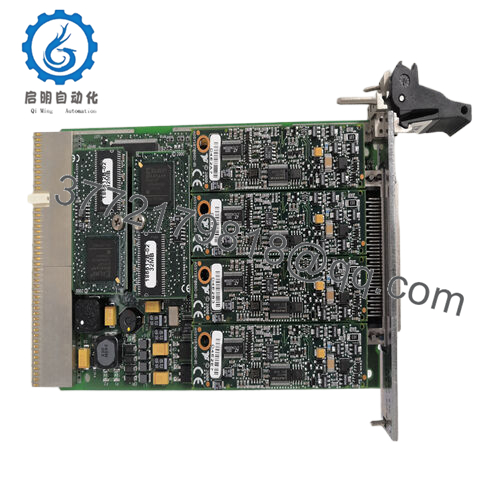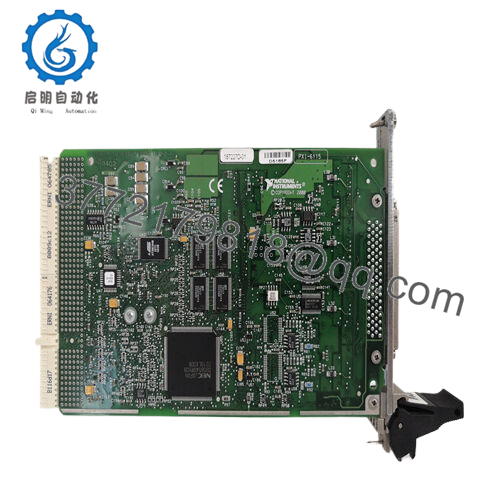Description
In the precision-driven arena of industrial automation, where capturing high-speed transient signals—like ultrasonic waveforms or radar pulses—demands uncompromised fidelity to prevent skewed analyses or missed anomalies in real-time control loops, engineers often grapple with the limitations of sequential sampling that introduces phase skew or undersampling artifacts. Envision a sonar array in marine propulsion or an automotive crash test rig: multiple transducers fire simultaneously, generating overlapping analog events that must be digitized at 10 MS/s per channel without crosstalk or timing jitter, yet legacy DAQ cards falter under load, yielding noisy I/O signals that cascade into faulty PID tuning or validation failures under ISO 26262 or MIL-STD-810 rigors. This sampling shortfall not only erodes process control but heightens risks in high-reliability testbeds, where a lagged waveform could obscure a structural flaw, inflating debug cycles and delaying certifications that tie up timelines for months.
The NI PXI-6115 steps forward as the synchronized sentinel in the S Series multifunction DAQ lineup, resolving these challenges by delivering simultaneous 12-bit sampling across four analog inputs at 10 MS/s per channel, complemented by two analog outputs, eight digital I/O lines, and dual 24-bit counters for precise event timing. It becomes essential in environments chasing waveform integrity, such as ultrasound imaging in medical device prototyping or vibration profiling in aerospace composites, where multi-channel concurrency is non-negotiable amid EMI-heavy enclosures. From test fixtures I’ve configured in radar labs, teams routinely wrestle with pipelined delays in older PCI boards that distort stimulus-response pairs, demanding workarounds like external clocks that bloat budgets and complicate PXI chassis integrations. The NI PXI-6115 dispels this by leveraging a shared ADC clock for phase-coherent captures, with NI-DAQmx drivers enabling seamless synchronization via PXI trigger bus, so you focus on algorithm refinement rather than artifact hunts. In the high-fidelity fabric of industrial automation, it anchors the acquisition layer with modular versatility, where signal reliability from transducers drives everything from HIL simulations to automated test sequences, turning potential pitfalls into precise profiles that align with AS9100 standards.
By fusing simultaneous sampling with flexible triggering—digital or analog—into a hybrid-slot PXI form factor, the NI PXI-6115 empowers scalable data pipelines that adapt to evolving test demands, from benchtop proofs to rack-scale deployments. It’s the DAQ dexterity designed for those concurrency-critical contexts in process control, where a microsecond’s misalignment means measurement misses, delivering the channel coherence that calibrates confidence and sustains sequences.
When slotting the NI PXI-6115 into a PXI or PXIe chassis for multi-modal signal capture, it operates as the concurrent conditioner at the acquisition apex, multiplexing four pseudodifferential AI channels through a shared 12-bit ADC clock to acquire waveforms up to ±10 V ranges at 10 MS/s each, while the two 16-bit AO channels generate stimulus signals at up to 2.5 MS/s with FIFO buffering for seamless loopback testing. It interfaces via the PXI backplane for star-triggered sync with adjacent modules—like digitizers or scope cards—drawing +5 VDC from the chassis rails and exposing eight TTL-compatible DIO lines plus two 24-bit counter/timers for frequency or pulse-width duties, bridging the transducer tier to host controllers where LabVIEW or TestStand orchestrates buffered acquisitions.

- PXI-6115

- PXI-6115
In execution, it converses via NI-DAQmx APIs, where tasks configure filters (e.g., 50 kHz low-pass) or export triggers over PXI_TRIG lines for multi-device handshakes, while onboard 32 MB memory per channel buffers bursts up to 3,200 samples without host intervention, ideal for transient hunts in radar chirps. Diagnostics run continuously, flagging overrange or clock faults via software events, and the digital triggering supports edge or window modes for precise arming, with galvanic isolation options shielding against ground loops in automotive bays. No external clocks needed; it generates internal references up to 20 MHz, supporting correlated AO/AI for feedback loops or DIO-patterned stimulus.
This modularity shines in hybrid chassis, where it pairs upstream with timing modules for sub-ns sync and downstream with frame grabbers for sensor fusion, enabling redundant configs for MIL-STD-1399 power sims where one channel shadows for fault masking. For retrofits, it swaps legacy PCI-6115 boards without rewiring, its SCXI compatibility easing analog front-ends. This isn’t isolated input; the NI PXI-6115 embeds simultaneity into the stack, crafting a process control cadence where waveforms weave without warp, anticipating the acquisitions that affirm accuracy.
| Specification | Details |
|---|---|
| Model Number | PXI-6115 |
| Brand | National Instruments (NI) |
| Type | Multifunction DAQ Module |
| Input Voltage | ±10 V (AI), 0-5 V (DIO) |
| Operating Temp Range | 0°C to 55°C |
| Mounting Style | PXI / PXIe Chassis Slot |
| Dimensions | 16 x 10 cm (6.3 x 3.9 in) |
| Weight | 0.3 kg |
| Interface/Bus | PXI Backplane / NI-DAQmx |
| Compliance | CE, FCC, RoHS, MIL-STD-810 |
| Supported Protocols | PXI Trigger Bus, RTSI |
| Typical Power Draw | 15 W |
Incorporating the NI PXI-6115 yields a bedrock of waveform wisdom that bolsters test throughput, where simultaneous sampling unveils subtle skews in multi-sensor arrays—think resolving a 100 ns phase offset in sonar pings before it biases beamforming, curtailing the calibration cascades that clog labs for days and compromise compliance proofs. Engineered for the transient tempests of test theaters, it ensures long-term linearity via self-calibration cycles, so thermal drifts or ADC pipeline delays don’t degrade digits, furnishing the dynamic range that defines decision domains and defers digitizer downtime without diagnostic detours.
This module also streamlines sequence sovereignty, its DAQmx event-driven I/O and buffer overflows expediting error etymologies to elemental exams over exhaustive explorations—vital in chassis where channel churn challenges cognition and cycle times constrain. In PXI portfolios, it diminishes deployment drudgery by dovetailing chassis canons, so system suites swell sans sync skirmishes or trigger tweaks, vectoring vigor to visionary ventures like Python-scripted HIL. Test teams tap its task templates for tactical tunes, where DIO dials deliver deterministic duties intuitively, instilling interfaces that interpret inputs as imperatives, not impositions.
Deeper, the NI PXI-6115 gestates acquisition acuity, its 10 MS/s tenacity tempering timing tremors to tower MTBF, while versatile vectors—AI to counters—vest in varied vignettes sans variant vexes. The transmissions transmute: tempered telemetries that transmute turnarounds, ledger-lucid ledgers for levy lulls, and the ken to knit networked narratives for networked narratives, all netted in a module that doesn’t dally digits, but dispatches them into your automation’s discerning dominion.
In automotive NVH labs, the NI PXI-6115 captures accelerometer barrages and shaker commands amid road-sim rumbles, leveraging PXI triggers for critical system uptime via phase-locked loops—essential for process control environments where skew slips could skew soundscapes and stall safety validations. Its buffer bounty banks bursts under broadband blasts, upholding high reliability in bays benchmarking bumpers.
For aerospace radar R&D, it’s chassis’d to profile pulse echoes through EMI eddies, prevailing against anechoic airs for continuous uptime, with AO analogs arming agile antennas. The NI PXI-6115 bolsters modular integration, broadening benches buoyantly for beam builds without beacon bifurcations.
In ultrasound medtech prototypes, the NI PXI-6115 tallies transducer transients in tissue tanks, reinforcing fast data cycles for beam forwards in fluid fluxes—harnessed in process control environments hewing to ISO 13485 to hinder harmonic harms and husband healing hauls.
PXI-6124 – Higher-channel sibling with 16-bit resolution for denser analog arrays in scope-like apps.
PXI-6110 – Compact 4-channel alternative at 5 MS/s for lighter waveform watches in space-pinched chassis.
PXI-6259 – M Series upgrade with 16 AI at 1.25 MS/s for mixed-signal HIL in control loops.
PCI-6115 – Desktop PCI counterpart for non-chassis bench tests with identical sampling specs.
PXIe-6363 – X Series evolution with 80 MHz clocks for sub-ns sync in advanced radar.
PXI-6602 – Counter-only companion for expanded timing in event-heavy sequences.
PXI-6733 – AO-focused module for stimulus extensions in closed-loop stimulus-response.
Before chassis-committing the NI PXI-6115, confirm your slot specs—hybrid PXIe needs adapter brackets for legacy frames, and tally trigger lines via MAX to preempt bus conflicts; preset tasks in NI-DAQmx offline mocks to nail ranges, amber LEDs at boot beckoning buffer imbalances. Engage slot levers till locked, then poll backplane via power cues—steady green per channel confirms clock quorum, flickers flagging fixture fumbles. Acquisition airs alter: allocate 50mm airflow around the card in dusty domains, and bond chassis per ESD to curb coupled currents from cabling.
In stride, semestral sheath scans at BNC junctions stave signal skips, notably in humid HILs—depower domains, ohm to ground, and log lags exceeding 1 MOhm. Quarterly, queue queue tests with gen sources to vet voltage verities, archiving against apertures; anomalous amps augur amp adjustments under acquisition. Annual full-chassis calibrations during cooldowns—injecting sine sweeps—validate simultaneity sans sensor swaps, while DAQmx drivers update post-config cache. These DAQ doctrines, distilled from digitizer diaries, dynamize the module’s mettle, deflecting the dim drifts that dull dynamic dawns.

 WhatsApp: +86 16626708626
WhatsApp: +86 16626708626 Email:
Email:  Phone: +86 16626708626
Phone: +86 16626708626


